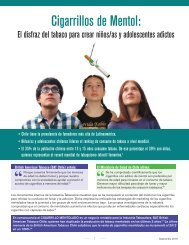Public health successes and missed opportunities
Public-health-successes-and-missed-opportunities-alcohol-mortality-19902014
Public-health-successes-and-missed-opportunities-alcohol-mortality-19902014
You also want an ePaper? Increase the reach of your titles
YUMPU automatically turns print PDFs into web optimized ePapers that Google loves.
Monitoring alcohol exposure<br />
Box 1. Estimating the level of unrecorded alcohol consumption<br />
This report is based on the best available data from all sources for different categories of unrecorded<br />
consumption (22,28,30):<br />
• surveys (such as the STEPwise approach to surveillance (STEPS)) where use of unrecorded alcohol is asked<br />
in the exp<strong>and</strong>ed alcohol module (32);<br />
• expert Delphi rounds;<br />
• industry estimates; <strong>and</strong><br />
• research studies.<br />
However, even based on this best available <strong>and</strong> recently increasing evidence base, the quantification of<br />
unrecorded consumption is still fraught with difficulties <strong>and</strong> contains considerably more bias than recorded<br />
consumption.<br />
Tourist consumption was estimated with the algorithm developed for the Global status report on alcohol <strong>and</strong> <strong>health</strong> (1),<br />
based on World Bank data on the annual number of tourists per country. This algorithm specifies that tourist consumption<br />
is taken into account only if the number of tourists exceeds the number of inhabitants, with special consideration given<br />
to the proportion of Muslims in the country (33).<br />
The sum of recorded, unrecorded <strong>and</strong> tourist consumption (all measured in adults – defined as age 15 years <strong>and</strong> older<br />
– per capita consumption of pure alcohol) yields total alcohol consumption. All trends are presented as moving threeyear<br />
averages to reduce some of the r<strong>and</strong>om yearly variation. For estimates of consumption per drinker, adult per capita<br />
alcohol consumption data were divided by the proportion of drinkers, separated by sex. Any information on drinking by<br />
sex <strong>and</strong> age was derived from surveys, collected by the WHO Collaborating Centre (34) <strong>and</strong> made publicly available via<br />
the GISAH (15) (see Web Appendix 60 for an overview of sources for surveys on drinking status).<br />
The yearly per country population size by sex <strong>and</strong> age was taken from the United Nations Population Division (35).<br />
COUNTRIES AND REGIONS<br />
All countries with separate estimates of recorded <strong>and</strong> unrecorded consumption over time were included: Albania, Armenia,<br />
Austria, Azerbaijan, Belarus, Belgium, Bosnia <strong>and</strong> Herzegovina, Bulgaria, Croatia, Cyprus, the Czech Republic, Denmark,<br />
Estonia, Finl<strong>and</strong>, France, Georgia, Germany, Greece, Hungary, Icel<strong>and</strong>, Irel<strong>and</strong>, Israel, Italy, Kazakhstan, Kyrgyzstan, Latvia,<br />
Lithuania, the former Yugoslav Republic of Macedonia, Malta, the Republic of Moldova, Montenegro, the Netherl<strong>and</strong>s,<br />
Norway, Pol<strong>and</strong>, Portugal, Romania, the Russian Federation, Serbia, Slovakia, Slovenia, Spain, Sweden, Switzerl<strong>and</strong>,<br />
Tajikistan, Turkey, Turkmenistan, Ukraine, the United Kingdom of Great Britain <strong>and</strong> Northern Irel<strong>and</strong>, <strong>and</strong> Uzbekistan.<br />
Estimates of exposure for Luxembourg are also presented, but these estimates were derived via the consumption in the<br />
neighbouring countries, as it is difficult to determine how much alcohol is sold to people living in this country as opposed<br />
to people from surrounding countries (i.e. France <strong>and</strong> Germany), or how often inhabitants of these countries buy their<br />
alcoholic beverages in surrounding countries. The countries with consumption trends shown in Fig. 1–9 comprise all<br />
countries in the WHO European Region with the exception of the following small countries: Andorra, Monaco <strong>and</strong> San<br />
Marino.<br />
During the observation period, there was considerable political change, <strong>and</strong> some of the countries above achieved political<br />
independence after 1990. Usually, data are presented from the year of political independence or, in case estimates<br />
existed for years before independence, for these years as well (for instance, for the Czech Republic, data are presented<br />
from 1990, even though Czechoslovakia split up into the Czech Republic <strong>and</strong> Slovakia only in 1993). Any national trends<br />
in per capita consumption are based on three-year moving averages.<br />
3




